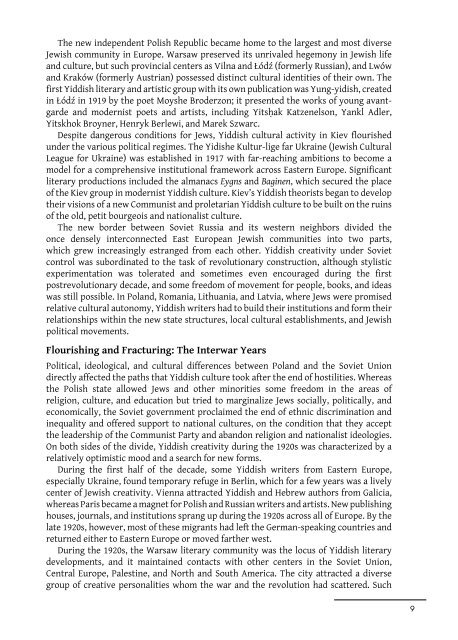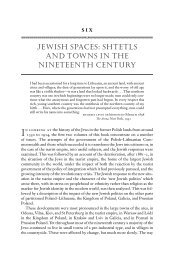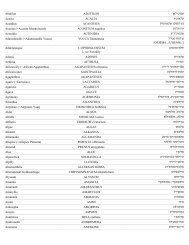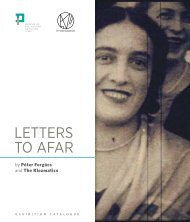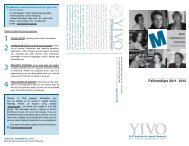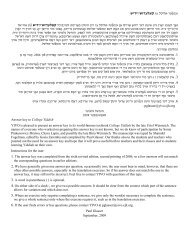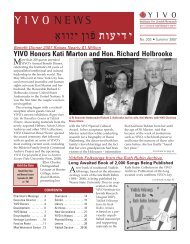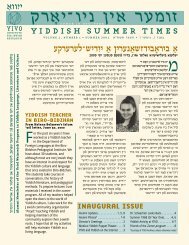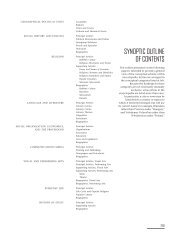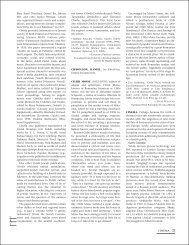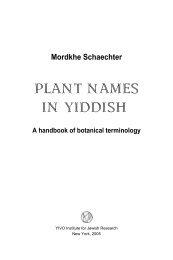geographical–political units - YIVO Institute for Jewish Research
geographical–political units - YIVO Institute for Jewish Research
geographical–political units - YIVO Institute for Jewish Research
You also want an ePaper? Increase the reach of your titles
YUMPU automatically turns print PDFs into web optimized ePapers that Google loves.
The new independent Polish Republic became home to the largest and most diverse<br />
<strong>Jewish</strong> community in Europe. Warsaw preserved its unrivaled hegemony in <strong>Jewish</strong> life<br />
and culture, but such provincial centers as Vilna and Łódź (<strong>for</strong>merly Russian), and Lwów<br />
and Kraków (<strong>for</strong>merly Austrian) possessed distinct cultural identities of their own. The<br />
first Yiddish literary and artistic group with its own publication was Yung-yidish, created<br />
in Łódź in 1919 by the poet Moyshe Broderzon; it presented the works of young avantgarde<br />
and modernist poets and artists, including Yitsḥak Katzenelson, Yankl Adler,<br />
Yitskhok Broyner, Henryk Berlewi, and Marek Szwarc.<br />
Despite dangerous conditions <strong>for</strong> Jews, Yiddish cultural activity in Kiev flourished<br />
under the various political regimes. The Yidishe Kultur-lige far Ukraine (<strong>Jewish</strong> Cultural<br />
League <strong>for</strong> Ukraine) was established in 1917 with far-reaching ambitions to become a<br />
model <strong>for</strong> a comprehensive institutional framework across Eastern Europe. Significant<br />
literary productions included the almanacs Eygns and Baginen, which secured the place<br />
of the Kiev group in modernist Yiddish culture. Kiev’s Yiddish theorists began to develop<br />
their visions of a new Communist and proletarian Yiddish culture to be built on the ruins<br />
of the old, petit bourgeois and nationalist culture.<br />
The new border between Soviet Russia and its western neighbors divided the<br />
once densely interconnected East European <strong>Jewish</strong> communities into two parts,<br />
which grew increasingly estranged from each other. Yiddish creativity under Soviet<br />
control was subordinated to the task of revolutionary construction, although stylistic<br />
experimentation was tolerated and sometimes even encouraged during the first<br />
postrevolutionary decade, and some freedom of movement <strong>for</strong> people, books, and ideas<br />
was still possible. In Poland, Romania, Lithuania, and Latvia, where Jews were promised<br />
relative cultural autonomy, Yiddish writers had to build their institutions and <strong>for</strong>m their<br />
relationships within the new state structures, local cultural establishments, and <strong>Jewish</strong><br />
political movements.<br />
Flourishing and Fracturing: The Interwar Years<br />
Political, ideological, and cultural differences between Poland and the Soviet Union<br />
directly affected the paths that Yiddish culture took after the end of hostilities. Whereas<br />
the Polish state allowed Jews and other minorities some freedom in the areas of<br />
religion, culture, and education but tried to marginalize Jews socially, politically, and<br />
economically, the Soviet government proclaimed the end of ethnic discrimination and<br />
inequality and offered support to national cultures, on the condition that they accept<br />
the leadership of the Communist Party and abandon religion and nationalist ideologies.<br />
On both sides of the divide, Yiddish creativity during the 1920s was characterized by a<br />
relatively optimistic mood and a search <strong>for</strong> new <strong>for</strong>ms.<br />
During the first half of the decade, some Yiddish writers from Eastern Europe,<br />
especially Ukraine, found temporary refuge in Berlin, which <strong>for</strong> a few years was a lively<br />
center of <strong>Jewish</strong> creativity. Vienna attracted Yiddish and Hebrew authors from Galicia,<br />
whereas Paris became a magnet <strong>for</strong> Polish and Russian writers and artists. New publishing<br />
houses, journals, and institutions sprang up during the 1920s across all of Europe. By the<br />
late 1920s, however, most of these migrants had left the German-speaking countries and<br />
returned either to Eastern Europe or moved farther west.<br />
During the 1920s, the Warsaw literary community was the locus of Yiddish literary<br />
developments, and it maintained contacts with other centers in the Soviet Union,<br />
Central Europe, Palestine, and North and South America. The city attracted a diverse<br />
group of creative personalities whom the war and the revolution had scattered. Such<br />
9


